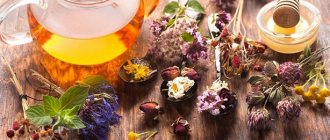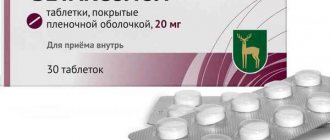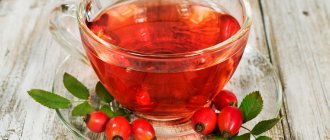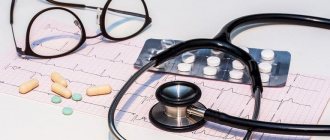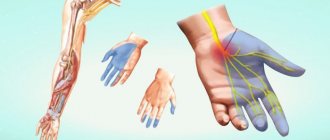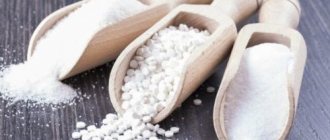Causes and symptoms of tachycardia
There are three types of tachycardia: physiological, pathological and short-term. The main causes of pathology:
- excess caffeine-containing products in the diet;
- heart and vascular diseases (hypertension, heart attack, heart failure);
- endocrine disorders (diabetes mellitus, thyroid problems);
- the presence of inflammatory processes of an infectious nature in the body;
- hormonal imbalance associated with pregnancy.
Typical symptoms of tachycardia include:
- squeezing pain in the chest;
- increased heart rate while at rest;
- “floaters” in the eyes;
- fainting conditions;
- dizziness and weakness.
Return to contents
Can I drink tea?
Black and green
It is forbidden to drink strongly brewed black tea; it is better to replace it with green tea (pure or with additives). For brewing, take 1 tsp. tea and pour a glass of boiling water. Leave for 15 minutes and drink with honey or sugar. The drink can be brewed a second time, without losing its aroma and healing properties. Green tea can normalize blood pressure levels, improve heart function and relieve symptoms of tachycardia.
Herbal teas for tachycardia
The recipe for making herbal tea is presented in the table:
| Ingredients | Quantity | Preparation | Application |
| Sunflower flowers | 2 tbsp. l. |
| You can drink one cup of tea 2-3 times a day. Immediately before drinking, sweeten the drink with sugar or honey. |
| pharmaceutical camomile | 1 tbsp. l. | ||
| Blackcurrant leaves/branches | 50 g | ||
| Dried or fresh mint | 30 g |
Return to contents
Rosehip for tachycardia
In order to prevent tachycardic attacks, decoctions of rose hips are taken. Recipe:
- Take ½ cup of rose hips.
- Pour boiling water in an amount of 1 liter and infuse in a thermos.
- Next, take half a glass of the decoction 3 times a day after meals.
If there are no fruits, use the leaves of the bush in combination with yarrow. An aqueous infusion is prepared from this collection, which helps reduce heart rate and normalize blood pressure. The raw materials in a 1:1 combination are poured with hot water and kept for a quarter of an hour in a water bath. Leave for 8 hours and drink ¼ glass three times a day before meals.
Melissa for therapy
The plant is used to normalize pulse and heart rhythm, as a sedative for the central nervous system. Ordinary tea is prepared from lemon balm. Preparation procedure:
- Take 1 tbsp. l. crushed raw materials.
- Fill with boiling water (500 ml).
- The drink is infused for about 10 minutes.
- Drink instead of water throughout the day.
Return to contents
Koporye tea
Commonly called Ivan-tea (fireweed). It is a plant used to treat many diseases and ailments. It has good sedative and sedative properties. Medicinal decoctions, infusions and teas are prepared from it. You can collect the raw materials yourself or purchase them ready-made at the pharmacy. To get rid of tachycardia, Ivan tea is used in this way:
- Take 2 tsp. raw materials (dried or fresh).
- Pour boiling water in an amount of 500 ml.
- Leave for 15 minutes.
- Strain and drink half a glass 3 times a day.
- The therapeutic course will last at least 2 weeks.
Return to contents
Other healing drinks
Hawthorn extract
The finished medicine is sold at any pharmacy, it is inexpensive and therapeutically effective. Hawthorn extract is used for high blood pressure, rapid pulse and palpitations to reduce blood pressure. It is produced on a water and alcohol basis. An aqueous extract is used to treat children, and an alcoholic extract is used for adults. You need to take the product 1 tbsp. l. three times a day before meals. The duration of therapy will be 1 month. The drug will eliminate the symptoms of arrhythmia and tachycardia.
Tincture of elecampane
The medicine is used in the fight against tachycardia caused by severe stress or overwork. It is prepared exclusively from the roots of the plant; if you use the leaves and stems, the desired effect will not occur. The tincture is prepared very simply:
- Take ¼ cup of chopped plant roots.
- Combine with vodka or alcohol (250 ml).
- Infuse the product for 2 weeks in a cool, dark place.
- Take 20 drops three times a day before or after meals.
- The course of treatment will take 2 weeks.
Return to contents
Valerian decoction
The herbal medicine has a positive effect on the central nervous system, calms the nerves and normalizes heart palpitations. A decoction is prepared from valerian: take 1 tbsp. l. raw materials and brewed like tea. Leave for 10 minutes and drink with added sugar or honey. The dosage per day should not exceed more than 1 glass. Valerian should be taken for at least 1 month.
Source: etodavlenie.ru
Other means
Based on hawthorn
This product is sold in pharmacies and is produced on the basis of water and alcohol. Hawthorn extract has a therapeutic effect for hypertension, increased pulse rate and heartbeat. For children, a water infusion can be used, and for adults, an alcohol infusion. Take the medicine 1 tbsp. spoon 3 times 24 hours before eating. The treatment course is 1 month.
Infusion of elecampane
This medicine will be effective for tachycardia caused by stress and fatigue. An infusion is prepared only from the roots of the plant. If you add other parts, the infusion will be less effective. Small parts of the root parts (¼ cup) are poured with alcohol (250 ml). The liquid is left for 14 days in a dark, cold place. The duration of treatment is 2 weeks.
Valerian decoction
This remedy has a positive effect on the human central nervous system, calms, and normalizes the heartbeat. To prepare the decoction, take the raw material (1 tablespoon) and brew it according to the same method as regular tea. Leave for 10 minutes. On the day of this medicine you need to drink 1 glass and no more. Treatment lasts 30 days.
Green tea “plants” the heart, and milk - the kidneys
Does milk cause kidney stones?
A group of nutritionists from the University of Munich systematized data on how this drink actually affects the human body. Of course, it also removes toxins from the body and helps the production of immune cells. But there were also disadvantages.
According to scientists, you should limit your milk consumption if you have a tendency to form kidney or gallstones. It is also one of the five most powerful food allergens. If a person suffering from lactose intolerance drinks a glass of milk, he may even experience anaphylactic shock. But approximately 8-10% of the European population suffers from milk intolerance! Attempts to try it end in bloating and indigestion. The reason is that these people do not produce the stomach enzyme lactase, which breaks down milk sugars.
You should avoid whole milk if you have tumors of internal organs. Its bioactive substances can provoke their growth.
Also, natural milk is not recommended for arthritis. Lactic acid increases inflammation in the joints. In these cases, it makes sense to use soy milk.
Tea hits the stomach and blood vessels
Until recently, coffee was blamed for heart rhythm disturbances, but now it has been rehabilitated, but questions have arisen regarding tea. A team of cardiologists from the University of Toronto (Canada) warns that strong tea can cause tachycardia - an increase in heart rate. And green in this sense is stronger than black. It contains more bioactive substances that act on the walls of blood vessels.
In tea, caffeine is bound by tannins - tannins. Therefore, it acts softer, but longer than in coffee. The effect is achieved gradually and lasts up to 6 hours. But if you drink too strong tea, the caffeine will immediately excite both the nervous system and blood vessels.
By the way, a weak infusion of tea lowers blood pressure, while a strong infusion (especially with sugar), on the contrary, increases it.
Causes and symptoms of tachycardia
There are three types of tachycardia: physiological, pathological and short-term. The main causes of pathology:
- excess caffeine-containing products in the diet;
- heart and vascular diseases (hypertension, heart attack, heart failure);
- endocrine disorders (diabetes mellitus, thyroid problems);
- the presence of inflammatory processes of an infectious nature in the body;
- hormonal imbalance associated with pregnancy.
Typical symptoms of tachycardia include:
- squeezing pain in the chest;
- increased heart rate while at rest;
- “floaters” in the eyes;
- fainting conditions;
- dizziness and weakness.
Return to contents
Can I drink tea?
Black and green
It is forbidden to drink strongly brewed black tea; it is better to replace it with green tea (pure or with additives). For brewing, take 1 tsp. tea and pour a glass of boiling water. Leave for 15 minutes and drink with honey or sugar. The drink can be brewed a second time, without losing its aroma and healing properties. Green tea can normalize blood pressure levels, improve heart function and relieve symptoms of tachycardia.
Herbal teas for tachycardia
The recipe for making herbal tea is presented in the table:
| Ingredients | Quantity | Preparation | Application |
| Sunflower flowers | 2 tbsp. l. |
| You can drink one cup of tea 2-3 times a day. Immediately before drinking, sweeten the drink with sugar or honey. |
| pharmaceutical camomile | 1 tbsp. l. | ||
| Blackcurrant leaves/branches | 50 g | ||
| Dried or fresh mint | 30 g |
Return to contents
Rosehip for tachycardia
In order to prevent tachycardic attacks, decoctions of rose hips are taken. Recipe:
- Take ½ cup of rose hips.
- Pour boiling water in an amount of 1 liter and infuse in a thermos.
- Next, take half a glass of the decoction 3 times a day after meals.
If there are no fruits, use the leaves of the bush in combination with yarrow. An aqueous infusion is prepared from this collection, which helps reduce heart rate and normalize blood pressure. The raw materials in a 1:1 combination are poured with hot water and kept for a quarter of an hour in a water bath. Leave for 8 hours and drink ¼ glass three times a day before meals.
Melissa for therapy
The plant is used to normalize pulse and heart rhythm, as a sedative for the central nervous system. Ordinary tea is prepared from lemon balm. Preparation procedure:
- Take 1 tbsp. l. crushed raw materials.
- Fill with boiling water (500 ml).
- The drink is infused for about 10 minutes.
- Drink instead of water throughout the day.
Return to contents
Koporye tea
Commonly called Ivan-tea (fireweed). It is a plant used to treat many diseases and ailments. It has good sedative and sedative properties. Medicinal decoctions, infusions and teas are prepared from it. You can collect the raw materials yourself or purchase them ready-made at the pharmacy. To get rid of tachycardia, Ivan tea is used in this way:
- Take 2 tsp. raw materials (dried or fresh).
- Pour boiling water in an amount of 500 ml.
- Leave for 15 minutes.
- Strain and drink half a glass 3 times a day.
- The therapeutic course will last at least 2 weeks.
Return to contents
Other healing drinks
Hawthorn extract
The finished medicine is sold at any pharmacy, it is inexpensive and therapeutically effective. Hawthorn extract is used for high blood pressure, rapid pulse and palpitations to reduce blood pressure. It is produced on a water and alcohol basis. An aqueous extract is used to treat children, and an alcoholic extract is used for adults. You need to take the product 1 tbsp. l. three times a day before meals. The duration of therapy will be 1 month. The drug will eliminate the symptoms of arrhythmia and tachycardia.
Tincture of elecampane
The medicine is used in the fight against tachycardia caused by severe stress or overwork. It is prepared exclusively from the roots of the plant; if you use the leaves and stems, the desired effect will not occur. The tincture is prepared very simply:
- Take ¼ cup of chopped plant roots.
- Combine with vodka or alcohol (250 ml).
- Infuse the product for 2 weeks in a cool, dark place.
- Take 20 drops three times a day before or after meals.
- The course of treatment will take 2 weeks.
Return to contents
Valerian decoction
The herbal medicine has a positive effect on the central nervous system, calms the nerves and normalizes heart palpitations. A decoction is prepared from valerian: take 1 tbsp. l. raw materials and brewed like tea. Leave for 10 minutes and drink with added sugar or honey. The dosage per day should not exceed more than 1 glass. Valerian should be taken for at least 1 month.
Source: etodavlenie.ru
Vitamin and mineral mixtures
- You need to chop and mix 100 g of dried apricots, 15 almonds, 3 lemons, pour honey over everything and add 15 drops of pharmaceutical tinctures of valerian and hawthorn. The resulting mixture is stored in the refrigerator, and taken one tablespoon on an empty stomach in the morning and evening.
- Mix the kernels of four walnuts, a glass of raisins and 40 g of honey and extend the intake of the resulting mixture for 45 days.
By taking these mixtures, you can restore the balance of sodium, potassium, calcium and magnesium in the body, and this will have a beneficial effect on cardiac activity.
The combination of honey, dried apricots, nuts and lemon is a gentle classic mixture that contains all the necessary microelements and vitamins to normalize cardiac activity. This mixture can be drunk as a prophylactic to prevent tachycardia, even for adolescents and young children, if they are not allergic to any of the components. In addition, this folk treatment for tachycardia helps with home treatment of angina pectoris.
Do you know other folk remedies for tachycardia? Have you taken the decoctions and infusions described in the article, did they help you? Tell us about it in the comments - share your experience with other readers.
Coffee for tachycardia
With tachycardia, a person experiences a rapid heartbeat and complains of weakness and dizziness. This pathology occurs due to severe stress, addiction to alcoholic beverages, and lack of sleep.
Coffee is not capable of causing tachycardia. This condition occurs due to other circumstances. But the caffeine contained in the drink increases heart rate and blood pressure. This is why a feeling of tachycardia may occur after drinking coffee.
In order to reduce the likelihood of pathology, you need to limit the consumption of drinks containing caffeine. After coffee you should drink a small amount of water. This will reduce the concentration of caffeine in the body.
Many people are haunted by the question: is it possible to drink coffee if you have tachycardia? Experts recommend stopping drinking the drink if you have pathologies of the cardiovascular system. But what about a person who is used to starting the day with a cup of aromatic drink?
In this case, you need to pay attention to decaffeinated coffee. This drink should be drunk in the morning. In its taste and aroma it is not much different from regular coffee. The drink helps you wake up and gives you strength for new achievements. Decaffeinated coffee improves memory and increases concentration.
With a mild form of tachycardia, you can sometimes treat yourself to a cup of natural coffee. You can add milk or a small amount of cream to it. Sugar should not be put in coffee.
Does Corvalol reduce heart rate?
Does Corvalol reduce heart rate? Probably, many are familiar with the feeling when, during a prolonged heartbeat, 15 or 20 drops of the mixture helped get rid of unpleasant sensations, and doctors recommend taking this drug as first aid for tachycardia. But what is the effect of the medication based on? Is it possible to drink the mixture frequently during each attack or should I take another medicine?
Therapeutic effect
The therapeutic effect of any drug depends on its active components.
Corvalol contains:
- Phenobarbital. Causes inhibition of impulses in the cortex and subcortical zone of the brain, has a sedative effect.
- Menthol and peppermint oils. They have antispasmodic and choleretic effects.
- Ethyl bromoisovalerate. Combines the properties of an antispasmodic and a sedative.
Other components of the mixture do not have a pronounced effect on the human body and serve to enhance the effectiveness of the listed substances.
Based on the description of the active components, the effect of the Corvalol mixture can be described as follows:
- sedative components inhibit the transmission of nerve impulses, and the person gradually calms down;
- antispasmodics help relax blood vessels, and the myocardium no longer needs to contract with high frequency to ensure proper blood circulation.
The medicine begins to act after 10-15 minutes, the patient feels relief and a partial decrease in increased blood pressure (blood pressure).
But it is not enough to simply reduce the rapid heartbeat; you need to eliminate the cause of tachycardia.
Why does your heart rate increase?
An increase in heart rate during stress and physical activity is considered normal - it is necessary to ensure the increased need of tissues for oxygen under unfavorable conditions. Physiological tachycardias do not require treatment and go away on their own after eliminating the provoking factors.
Read also: Causes of tachycardia in pregnant women
But even seemingly causeless rapid heartbeats have their own hidden reasons:
- physical and mental fatigue;
- heart pathologies;
- vascular disorders;
- poor diet (excess fatty foods);
- alcohol abuse;
- smoking;
- obesity;
- abuse of caffeine-containing drinks (strong tea, coffee);
- lack of sleep;
- long stay in a stuffy room;
- overheating in the sun;
- inflammatory processes accompanied by intoxication of the body.
Cardiologists recommend taking Corvalol 15-20 drops, but not more than 4 times a day. Unfortunately, the pulse reduced by the medicine without appropriate treatment may increase again after a short time. Many patients, neglecting medical recommendations, begin to take medicine more often than recommended, which leads to various complications.
If we return to the above composition of the Corvalol mixture, we can be convinced that there is not a single component in it that helps eliminate provoking factors; the medicine is only capable of temporarily eliminating unpleasant symptoms.
The insidiousness of the medicine
The biggest trick is that the medicine is inexpensive and can be freely purchased in the pharmacy chain. This availability creates the illusion of safety of the drug, and many begin to take it often at the slightest sign of discomfort in the heart.
But Corvalol contains phenobarbital in small doses, which is classified as a narcotic drug and can accumulate in tissues. Long-term uncontrolled use of the drug leads primarily to disruption of brain function.
A person has:
- memory impairment;
- decreased concentration;
- deterioration of nervous reactions in response to external stimuli.
The sad result, if Corvalol is continued, is the development of dementia.
In addition, Phenobarbital, accumulating in tissues, has a toxic effect on cells, which leads to deterioration in the functioning of the myocardium, kidneys and liver, possibly causing heart or kidney failure.
But the most terrible consequence is the development of drug addiction. When discontinued, patients experience a sharp deterioration in their well-being: the heart rate increases, unmotivated aggression appears, and in rare cases an epileptic seizure develops. People are forced to constantly carry a bottle of medicine with them, not to stop an attack of palpitations, but in order to avoid severe symptoms associated with drug withdrawal syndrome. Patients with developed corvalol addiction need the help of a narcologist; it is almost impossible to get rid of the addiction to frequent use of the drug on your own.
Corvalol helps slow the pulse and lower blood pressure and can be used as a first aid remedy for sudden tachycardia. But uncontrolled use of the medication is unacceptable; it leads to drug addiction and Phenobarbital intoxication at the cellular level.
Does Corvalol reduce heart rate? It reduces, but for a short time, the medication cannot be used for a long time, it is dangerous for the body. To treat tachycardia, it is necessary to eliminate the cause of the increased heart rate.
Low blood pressure: how to raise it at home?
What is the relationship between green tea and blood pressure? For hypertensive patients, it is very important to control their diet. Habitual foods can do a disservice, so hypertension forces a person to reconsider his eating habits. Should I give up green tea if I have low blood pressure?
People have been drinking green tea for centuries. Its tonic and cleansing effect on the body has long been noticed. This is explained by a combination of beneficial enzymes and substances contained in the leaves of the bush:
- caffeine tones and adds vitality;
- tannins normalize the gastrointestinal tract;
- microelements strengthen the heart and vascular walls;
- amino acids protect the nervous system in stressful situations and stimulate metabolic processes.
Green tea leaves are an excellent diuretic. In addition to removing toxins and waste from the body, the drink helps against edema - one of the main causes of blood pressure surges. The effect of green tea on blood pressure: strong tea raises blood pressure, weakly brewed tea lowers it. Hot green tea for low blood pressure, drink cold tea for hypertension.
Hypotension, a condition in which blood pressure is constantly reduced, is no less dangerous for the body than hypertension. Indeed, at low pressure, oxygen along with the blood flows more slowly to all organs, including the brain. It is worth knowing how to raise low blood pressure as simply and without harm as possible, under what condition it is better to consult a doctor, and how to prevent heart problems in the future.
- Symptoms of hypotension
- How to raise blood pressure
- Quick ways to normalize blood pressure during hypotension
- What to raise in pregnant women
- How to increase with drugs
| How to measure pressure using the oscillometric method |
| What does pressure 170 to 110 mean and how to reduce it? |
Rules for measuring blood pressure using the Korotkoff method What heart pressure is considered elevated: normal table Low blood pressure readings: symptoms and treatment Normal blood pressure is considered to be 120 over 80, but in fact this norm is quite rare. Blood pressure readings can be influenced by many factors, so their fluctuations are considered absolutely normal. You should start worrying if, with high or low blood pressure, you feel unwell and have symptoms of cardiovascular system disorders.
Many different factors can lead to hypotension. Often, the development of this condition is influenced by a whole range of different reasons. The development of the disease can be affected by severe physical or emotional fatigue, poor nutrition with a lack of substances, vitamins and minerals necessary for the normal functioning of the body.
In people who are exposed to weather changes (weather dependent), hypotension is especially common. It occurs when weather conditions change and is often accompanied by joint pain and other symptoms of meteorological dependence.
Often, hypotension is only a consequence of existing health problems, so if your blood pressure is constantly low, you should consult a doctor and find out why this is happening. Constant attempts to increase blood pressure artificially without finding out the reasons for its decrease can only aggravate the situation.
Symptoms of hypotension
Low blood pressure compared to normal values does not mean that illness will necessarily occur. It is worth focusing on your own well-being. The following symptoms indicate that you should pay attention to your condition, take action and consult a doctor if it continues to worsen:
- headaches, often accompanied by dizziness;
- coldness and numbness of the limbs, hands and feet;
- mild nausea, drowsiness, disturbances in attention and coordination of movements.
heart rhythm disturbances, tachycardia;
If such symptoms occur, it is worth measuring your blood pressure and checking whether it is low. If it turns out to be too low, you should take action and raise it. This can be done using various folk remedies or medications.
How to raise blood pressure
If reduced levels occur constantly, you should take a look at your daily routine. An unbalanced diet, an irrational work and rest schedule, a lack of fresh air and physical activity can negatively affect the condition of the circulatory system. To cope with persistent hypotension, you must follow these rules:
- You should sleep at least 8–10 hours a day. Less sleep leads to hypotension, impaired attention, and depression.
- You should pay attention to morning exercises. Five to ten minutes of simple exercise every morning will help keep your body in good shape and prevent your blood pressure from rising.
- A morning contrast shower also has a positive effect on the condition of the circulatory system. It is not necessary to make the temperature difference very large - a few minutes of such a procedure are enough to increase vascular tone.
- You should have a full breakfast, since the first meal is extremely important. If there are no already discovered diseases of the circulatory system, you can drink a cup of strong coffee or tea.
- It is also important to eat a balanced diet throughout the day. The diet should contain all the necessary vitamins and other useful elements, and there should be no feeling of hunger during the day. It is better to eat small portions, avoid too sweet and salty foods, and drink enough fluids.
List of drugs
Medications are allowed to be taken only after consultation with your doctor. Sometimes situations occur when problems with the heart and blood pressure bother an absolutely healthy person.
"Atenolol." Belongs to the group of beta blockers. Used in the treatment of tachycardia, helps lower blood pressure. Available in tablet form, maximum daily dose 200 mg. Use before meals, use with caution during diabetes.
"Relium". The drug is available in the form of tablets and solution for injection. Tablets are taken at 5 mg. twice a day, after consultation with a doctor, the dosage may be increased.
Captopril. The action of the medicine is aimed at reducing blood pressure and normalizing heart rate. Depending on the patient’s condition, 1 - 2 tablets per day are prescribed.
It is necessary to maintain a healthy lifestyle, eat right, and also try to avoid stressful situations.
When choosing a medicine, you should take into account the cause of the disease and the individual characteristics of the body. In order not to aggravate the situation and avoid side effects, treatment is prescribed only by a cardiologist.
The following sources of information were used to prepare the material.
Tachycardia and high blood pressure - what medications to take?
Proper functioning of the heart is the key to a person’s well-being and vigor. For a certain age, there are norms for the number of heartbeats, the violation of which indicates a high probability of developing illnesses.
If the heart rate increases, we can talk about the development of tachycardia, which can be chronic or sudden.
Timely elimination of attacks and stopping subsequent ones will help to avoid premature wear of the heart muscles and the development of ischemia, which is a frequent companion to chronic palpitations and poses a danger to life.
Depending on the reason that caused the increased rhythm, the doctor may prescribe various medications that can be used in combination or separately from each other.
Often the cause of tachycardia is hormonal imbalance.
The thyroid gland, which secretes an increased amount of hormone, can provoke attacks of rapid heartbeat.
Due to the release of a large amount of triiodothyronine thyroxine, the metabolic process is accelerated, as a result of which the load on the heart and blood vessels increases, which provokes the development of tachycardia.
The dosage and duration of medication is determined by the doctor based on the data of a complete clinical examination and examination. This approach allows us to provide the patient with competent and effective treatment and significantly alleviate his condition.
Hypertension is one of the most dangerous diseases, which, if left untreated and timely measures taken, provokes the development of heart attacks and strokes.
Symptoms indicating the presence of hypertension are the following:
- vomit;
- nausea;
- dyspnea;
- swelling of the hands and feet;
- headache;
- blurred vision;
- other manifestations.
If the cause of tachycardia is hypertension, the doctor must take this fact into account and prescribe a special remedy for attacks of tachycardia in hypertension (for example, Anaprilin or Propranoprol).
Such drugs can not only reduce the heart rate, but also avoid the occurrence of a heart attack or stroke by reducing pressure on the walls of blood vessels and lowering blood pressure.
The duration of the treatment period and dosage volumes are selected by the attending physician taking into account the severity and intensity of the disease.
Can green tea cause tachycardia?
We will analyze the chemical composition in detail, focus on medical research and close the everyday topic “Is it worth heating up old tea?”
Tea is the most consumed drink in the world after water. At the same time, black tea (78%) is significantly ahead of green tea.
How black and green tea are made
The tea leaves are the leaves of the Camellia sinensis (Camellia sinensis). The homeland of tea is India and China.
The level of oxidation of the leaves determines the type of tea. Green tea is obtained from unoxidized leaves and is the least processed - unlike black tea, which is dried and roasted (under high temperatures).
The tea leaf contains about 300 chemical compounds, and not all of them have yet been identified.
During processing, the chemical composition of tea becomes even more complex and diverse. Some substances are lost, and, conversely, new ones are formed due to the oxidation and fermentation of existing ones. The study of tea composition is still ongoing.
The main groups of substances contained in tea
- alkaloids of the purine group;
- flavonoids;
- tannins;
- amino acids;
- vitamins;
- macro- and microelements.
All these substances are soluble in water and can be released into the tea solution, which means they enter the body when drinking tea. Let's look briefly at each group.
Alkoloids. What is the difference between caffeine in coffee and caffeine in tea?
Alkoloids in tea are nitrogen-containing substances with high functional activity: caffeine, theobromine, theophylline.
The caffeine content in dry leaves ranges from 1 to 4%; strong varieties of tea can contain up to 5%. Low-fermented green tea contains more caffeine than black tea.
What is the difference between caffeine in coffee and caffeine in tea? A cup of coffee contains 100-200 mg of caffeine (depending on the type and amount of coffee). Let's estimate the numbers for tea caffeine (of course, it all depends on the strength of the drink), take the average values. One standard tea bag – 2 g of dry tea leaves. The caffeine content in a tea cup ranges from 20 to 80-100 mg. Less than in coffee.
Coffee and tea. Photo from the website teakarta.rf
And the second, very important point! The caffeine in tea is bound with tannin (we'll talk about it below), forming theine or caffeine tannate. Theine gives tea a bitter taste and has a tonic effect on the body, similar to the effect of caffeine, but in a milder form:
- improves mental performance,
- increases physical activity,
- stimulates the cardiovascular and nervous system.
Another important advantage of tea:
Caffeine associated with tannin is eliminated from the body much faster, which ensures its short-term effect and does not lead to an overdose if tea is consumed frequently.
Therefore, there is no strict limit on the number of cups of tea. If you decide to give up coffee, but need its stimulating effect, switch to tea!
The alkaloids theobromine and theophylline (their content in tea is 0.5%) are antispasmodics (reduce the tone of the smooth muscles of internal organs) and have a vasodilator and diuretic effect.
I will also mention another substance from the group of alkaloids, this time harmful - guanine. When heated for a long time or when standing for a long time, it turns into a toxic substance - guanidine.
This is why it is not recommended to reheat previously prepared tea. Drink only freshly brewed drink!
Flavonoids. There are more of them in green tea
Flavonoids in tea are organic substances catechins (20-30% of dry matter). They determine the quality and beneficial properties of tea.
The more flavonoids, the better and tastier the tea.
Green tea retains the composition characteristic of fresh leaves; it contains the most catechins.
Catechins have the following effects:
- reduce the fragility and permeability of capillaries (the smallest blood vessels);
- prevent the development of atherosclerosis;
- have antioxidant effects (anti-aging and anti-carcinogenic effects);
- bacteriostatic, antiviral and immunostimulating effects;
- inhibit the development of Alzheimer's and Parkinson's diseases;
- have a cardioprotective effect, etc.
The amount of catechins in black tea is less due to their fermentation and transformation into yellow-orange pigment substances (theaflavins) and red-brown color (thearubins). Theaflavins and thearubins give black tea its astringent taste and characteristic color.
Black tea is also good for the cardiovascular system. After all, theaflavins and thearubins inhibit (reduce the rate) the development of atherosclerosis by reducing the “bad” fraction of cholesterol and increasing the “good” fraction.
Green tea. Photo from the site bezpuza.ru
Tannins. And again green tea is in the lead
Tannins are a mixture of polyphenolic compounds and their derivatives (15-30% dry matter).
The main component here is tannin (or theotanin). Its main effects:
- antioxidant (fights aging and the development of malignant diseases);
- reduces blood pressure;
- has a disinfectant and antimicrobial effect.
Green tea contains 2 times more tannins than black tea.
But the oxidation products of tannins - quinones - create the unique aroma of black tea.
There is much more ascorbic acid in tea than in citrus fruits
Now about other tea substances. About 25% of tea composition is proteins and amino acids. The amino acid theanine creates the taste of green tea.
Tea vitamins: provitamin A - carotene, B vitamins, ascorbic acid (in tea there is 2-3 times more of it than in citrus fruits!), vitamin PP, vitamin K.
Tea essential oils (0.08%) provide aroma and antimicrobial properties.
Macro- and microelements in tea (4-7%) - essentially, this is the entire periodic table: Fe, Mn, Mg, Na, Si, Ca, K, P, I, F, Cu, Au, etc.
Tea and lemons. Photo from wallpaperscraft.ru
The theory has been considered. What medical practice says
In 2006, the Journal of the American Medical Association published the results of a study that was conducted for 11 years on 40 thousand Japanese people aged 40 to 79 years.

